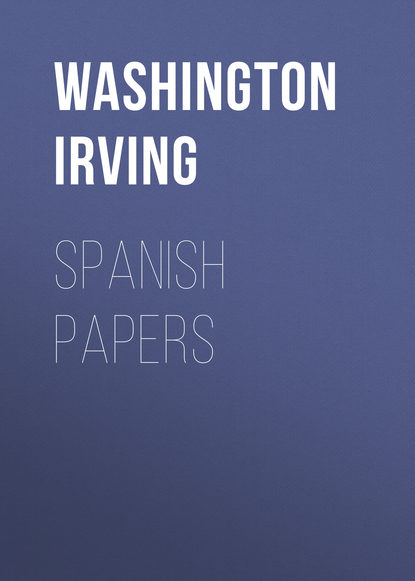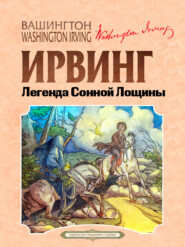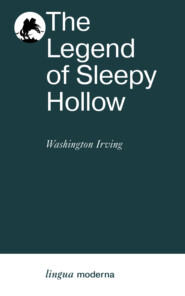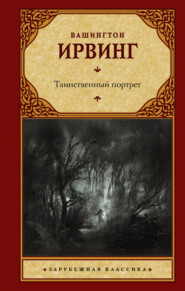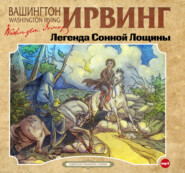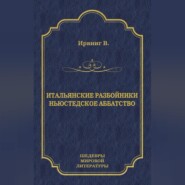По всем вопросам обращайтесь на: info@litportal.ru
(©) 2003-2025.
✖
Spanish Papers
Настройки чтения
Размер шрифта
Высота строк
Поля
“Señor,” said she, “I know that I am humble and unworthy of the notice of so noble a cavalier, but suffer me to place this ring on a finger of your right hand, with which you have so bravely rescued us from death; and when you regard it, you shall consider it as a memorial of your own valor, and not of one who is too humble to be remembered by you.” With these words she drew a ring from off her finger and put it upon the finger of Pelayo; and having done this, she blushed and trembled at her own boldness, and stood as one abashed, with her eyes cast down upon the earth.
Pelayo was moved at her words, and at the touch of her fair hand, and at her beauty as she stood thus troubled and in tears before him; but as yet he knew nothing of woman, and his heart was free from the snares of love. “Amiga” (friend), said he, “I accept thy present, and will wear it in remembrance of thy goodness.” The damsel was cheered by these words, for she hoped she had awakened some tenderness in his bosom; but it was no such thing, says the ancient chronicler, for his heart was ignorant of love, and was devoted to higher and more sacred matters; yet certain it is, that he always guarded well that ring.
They parted, and Pelayo and his huntsmen remained for some time on a cliff on the verge of the forest, watching that no evil befell them about the skirts of the mountain; and the damsel often turned her head to look at him, until she could no longer see him for the distance and the tears that dimmed her eyes.
And, for that he had accepted her ring, she considered herself wedded to him in her heart, and never married; nor could be brought to look with eyes of affection upon any other man, but for the true love which she bore Pelayo she lived and died a virgin. And she composed a book, continues the old chronicler, which treated of love and chivalry, and the temptations of this mortal life, – and one part discoursed of celestial things, – and it was called the “Contemplations of Love;” because at the time she wrote it she thought of Pelayo, and of his having received her jewel, and called her by the gentle name of “Amiga;” and often thinking of him, and of her never having beheld him more, in tender sadness she would take the book which she had written, and would read it for him, and, while she repeated the words of love which it contained, she would fancy them uttered by Pelayo, and that he stood before her.[58 - El Moro Rasis, Destruycion de España, pt. 2, c. 101.]
CHAPTER IV
Pilgrimage of Pelayo, and what befell him on his Return to Spain.
Pelayo, according to the old chronicle before quoted, returned to his home deeply impressed with the revelations made to him by the saintly hermit, and prepared to set forth upon the pilgrimage to the Holy Sepulchre. Some historians have alleged that he was quickened to this pious expedition by fears of violence from the wicked King Witiza; but at this time Witiza was in his grave, and Roderick swayed the Gothic sceptre; the sage Agapida is therefore inclined to attribute the pilgrimage to the mysterious revelation already mentioned.
Having arranged the concerns of his household, chosen the best suit of armor from his armory, and the best horse from his stable, and supplied himself with jewels and store of gold for his expenses, he took leave of his mother and his sister Lucinda, as if departing upon a distant journey in Spain, and, attended only by his page, set out upon his holy wayfaring. Descending from the rugged Pyrenees, he journeyed through the fair plains of France to Marseilles, where, laying by his armor, and leaving his horses in safe keeping, he put on a pilgrim’s garb, with staff and scrip and cockle-shell, and embarked on board of a galley bound for Sicily. From Messina he voyaged in a small bark to Rhodes; thence in a galliot, with a number of other pilgrims, to the Holy Land. Having passed a year of pious devotion at the Holy Sepulchre, and visited all the places rendered sacred by the footsteps of our Lord, and of his mother the ever-blessed Virgin, and having received the order of knighthood, he turned his steps toward his native land.
The discreet Agapida here pauses and forbears to follow the ancient chronicler further in his narration, for an interval of obscurity now occurs in the fortunes of Pelayo. Some who have endeavored to ascertain and connect the links of his romantic and eventful story, have represented him as returning from his pilgrimage in time to share in the last struggle of his country, and as signalizing himself in the fatal battle on the banks of the Guadalete. Others declare that by the time he arrived in Spain the perdition of the country was complete; that infidel chieftains bore sway in the palaces of his ancestors; that his paternal castle was a ruin, his mother in her grave, and his sister Lucinda carried away into captivity.
Stepping lightly over this disputed ground, the cautious Agapida resumes the course of the story where Pelayo discovers the residence of his sister in the city of Gijon, on the Atlantic coast, at the foot of the Asturian Mountains. It was a formidable fortress, chosen by Taric as a military post, to control the seaboard, and hold in check the Christian patriots who had taken refuge in the neighboring mountains. The commander of this redoubtable fortress was a renegado chief, who has been variously named by historians, and who held the sister of Pelayo a captive; though others affirm that she had submitted to become his wife, to avoid a more degrading fate. According to the old chronicle already cited, Pelayo succeeded by artifice in extricating her from his hands, and bearing her away to the mountains. They were hotly pursued, but Pelayo struck up a steep and rugged defile, where scarcely two persons could pass abreast, and partly by his knowledge of the defiles, partly by hurling down great masses of rock to check his pursuers, effected the escape of his sister and himself to a secure part of the mountains. Here they found themselves in a small green meadow, blocked up by a perpendicular precipice, whence fell a stream of water with great noise into a natural basin or pool, the source of the river Deva. Here was the hermitage of one of those holy men who had accompanied the Archbishop Urbano in his flight from Toledo, and had established a sanctuary among these mountains. He received the illustrious fugitives with joy, especially when he knew their rank and story, and conducted them to his retreat. A kind of ladder led up to an aperture in the face of the rock, about two pike lengths from the ground. Within was a lofty cavern capable of containing many people, with an inner cavern of still greater magnitude. The outer cavern served as a chapel, having an altar, a crucifix, and an image of the blessed Mary.
This wild retreat had never been molested; not a Moslem turban had been seen within the little valley. The cavern was well known to the Gothic inhabitants of the mountains and the adjacent valleys. They called it the cave of Santa Maria; but it is more commonly known to fame by the name of Covadonga. It had many times been a secure place of refuge to suffering Christians, being unknown to their foes, and capable of being made a natural citadel. The entrance was so far from the ground that, when the ladder was removed, a handful of men could defend it from all assault. The small meadow in front afforded pasturage and space for gardens; and the stream that fell from the rock was from a never-failing spring. The valley was high in the mountains; so high that the crow seldom winged its flight across it, and the passes leading to it were so steep and dangerous that single men might set whole armies at defiance.
Such was one of the wild fastnesses of the Asturias, which formed the forlorn hope of unhappy Spain. The anchorite, too, was one of those religious men permitted by the conquerors, from their apparently peaceful and inoffensive lives, to inhabit lonely chapels and hermitages, but whose cells formed places of secret resort and council for the patriots of Spain, and who kept up an intercourse and understanding among the scattered remnants of the nation. The holy man knew all the Christians of the Asturias, whether living in the almost inaccessible caves and dens of the cliffs, or in the narrow valleys imbedded among the mountains. He represented them to Pelayo as brave and hardy, and ready for any desperate enterprise that might promise deliverance; but they were disheartened by the continued subjection of their country, and on the point, many of them, of descending into the plains and submitting, like the rest of their countrymen, to the yoke of the conquerors.
When Pelayo considered all these things, he was persuaded the time was come for effecting the great purpose of his soul. “Father,” said he, “I will no longer play the fugitive, nor endure the disgrace of my country and my line. Here in this wilderness will I rear once more the royal standard of the Goths, and attempt, with the blessing of God, to shake off the yoke of the invader.”
The hermit hailed his words with transport, as prognostics of the deliverance of Spain. Taking staff in hand, he repaired to the nearest valley inhabited by Christian fugitives. “Hasten in every direction,” said he, “and proclaim far and wide among the mountains that Pelayo, a descendant of the Gothic kings, has unfurled his banner at Covadonga as a rallying-point for his countrymen.”
The glad tidings ran like wildfire throughout all the regions of the Asturias. Old and young started up at the sound, and seized whatever weapons were at hand. From mountain cleft and secret glen issued forth stark and stalwart warriors, grim with hardship, and armed with old Gothic weapons that had rusted in caves since the battle of the Guadalete. Others turned their rustic implements into spears and battle-axes, and hastened to join the standard of Pelayo. Every day beheld numbers of patriot warriors arriving in the narrow valley, or rather glen, of Covadonga, clad in all the various garbs of ancient Spain, – for here were fugitives from every province, who had preferred liberty among the sterile rocks of the mountains to ease and slavery in the plains. In a little while Pelayo found himself at the head of a formidable force, hardened by toil and suffering, fired with old Spanish pride, and rendered desperate by despair. With these he maintained a warlike sway among the mountains. Did any infidel troops attempt to penetrate to their stronghold, the signal fires blazed from height to height, the steep passes and defiles bristled with armed men, and rocks were hurled upon the heads of the intruders.
By degrees the forces of Pelayo increased so much in number, and in courage of heart, that he sallied forth occasionally from the mountains, swept the sea-coast, assailed the Moors in their towns and villages, put many of them to the sword, and returned laden with spoil to the mountains.
His name now became the terror of the infidels, and the hope and consolation of the Christians. The heart of old Gothic Spain was once more lifted up, and hailed his standard as the harbinger of happier days. Her scattered sons felt again as a people, and the spirit of empire arose once more among them. Gathering together from all parts of the Asturias in the Valley of Cangas, they resolved to elect their champion their sovereign. Placing the feet of Pelayo upon a shield, several of the starkest warriors raised him aloft, according to ancient Gothic ceremonial, and presented him as king. The multitude rent the air with their transports, and the mountain cliffs, which so long had echoed nothing but lamentations, now resounded with shouts of joy.[59 - Morales, Cronicon de España, L. 13, c. 2.] Thus terminated the interregnum of Christian Spain, which had lasted since the overthrow of King Roderick and his host on the banks of the Guadalete, and the new king continued with augmented zeal his victorious expeditions against the infidels.
CHAPTER V
The Battle of Covadonga.
Tidings soon spread throughout Spain that the Christians of the Asturias were in arms and had proclaimed a king among the mountains. The veteran chief, Taric el Tuerto, was alarmed for the safety of the seaboard, and dreaded lest this insurrection should extend into the plains. He despatched, therefore, in all haste, a powerful force from Cordova, under the command of Ibrahim Alcamar, one of his most experienced captains, with orders to penetrate the mountains and crush this dangerous rebellion. The perfidious Bishop Oppas, who had promoted the perdition of Spain, was sent with this host, in the hope that through his artful eloquence Pelayo might be induced to lay down his arms and his newly assumed sceptre.
The army made rapid marches, and in a few days arrived among the narrow valleys of the Asturias. The Christians had received notice of their approach, and fled to their fastnesses. The Moors found the valleys silent and deserted; there were traces of men, but not a man was to be seen. They passed through the most wild and dreary defiles, among impending rocks, – here and there varied by small green strips of mountain meadow, – and directed their march for the lofty valley, or rather glen, of Covadonga, whither they learnt from their scouts that Pelayo had retired.
The newly elected king, when he heard of the approach of this mighty force, sent his sister, and all the women and children, to a distant and secret part of the mountain. He then chose a thousand of his best armed and most powerful men, and placed them within the cave. The lighter armed and less vigorous he ordered to climb to the summit of the impending rocks, and conceal themselves among the thickets with which they were crowned. This done, he entered the cavern and caused the ladder leading to it to be drawn up.
In a little while the bray of distant trumpets, and the din of atabals resounded up the glen, and soon the whole gorge of the mountain glistened with armed men; squadron after squadron of swarthy Arabs spurred into the valley, which was soon whitened by their tents. The veteran Ibrahim Alcamar, trusting that he had struck dismay into the Christians by this powerful display, sent the crafty Bishop Oppas to parley with Pelayo, and persuade him to surrender.
The bishop advanced on his steed until within a short distance of the cave, and Pelayo appeared at its entrance with lance in hand. The silver-tongued prelate urged him to submit to the Moslem power, assuring him that he would be rewarded with great honors and estates. He represented the mildness of the conquerors to all who submitted to their sway, and the hopelessness of resistance. “Remember,” said he, “how mighty was the power of the Goths, who vanquished both Romans and Barbarians, yet how completely was it broken down and annihilated by these people. If the whole nation in arms could not stand before them, what canst thou do with thy wretched cavern and thy handful of mountaineers? Be counseled then, Pelayo; give up this desperate attempt; accept the liberal terms offered thee; abandon these sterile mountains, and return to the plains to live in wealth and honor under the magnanimous rule of Taric.”
Pelayo listened to the hoary traitor with mingled impatience and disdain. “Perdition has come upon Spain,” replied he, “through the degeneracy of her sons, the sins of her rulers, – like the wicked King Witiza thy brother, – and the treachery of base men like thee. But when punishment is at an end, mercy and forgiveness succeed. The Goths have reached the lowest extreme of misery; it is for me to aid their fortune in the turn, and soon I trust will it arise to its former grandeur. As to thee, Don Oppas, thou shalt stand abhorred among men, false to thy country, traitorous to thy king, a renegado Christian, and an apostate priest.”
So saying he turned his back upon the bishop and retired into his cave.
Oppas returned pale with shame and malice to Alcamar. “These people,” said he, “are stiff-necked in their rebellion; their punishment should be according to their obstinacy, and should serve as a terror to evil doers; not one of them should be permitted to survive.”
Upon this Alcamar ordered a grand assault upon the cavern; and the slingers and the cross-bow men advanced in great force, and with a din of atabals and trumpets that threatened to rend the very rocks. They discharged showers of stones and arrows at the mouth of the cavern, but their missiles rebounded from the face of the rock, and many of them fell upon their own heads. This is recorded as a miracle by pious chroniclers of yore, who affirm that the stones and arrows absolutely turned in the air and killed those who had discharged them.
When Alcamar and Oppas saw that the attack was ineffectual, they brought up fresh forces and made preparations to scale the mouth of the cavern. At this moment, says the old chronicle, a banner was put in the hand of Pelayo, bearing a white cross on a blood-red field, and inscribed on it in Chaldean characters was the name of Jesus. And a voice spake unto him and said, “Arouse thy strength; go forth in the name of Jesus Christ, and thou shalt conquer.” Who gave the banner and uttered the words has never been known; the whole, therefore, stands recorded as a miracle.
Then Pelayo elevated the banner. “Behold,” said he, “a sign from Heaven, – a sacred cross sent to lead us on to victory.”
Upon this the people gave a great shout of joy; and when the Saracens heard that shout within the entrails of the mountain their hearts quaked, for it was like the roar of a volcano giving token of an eruption.
Before they could recover from their astonishment, the Christians issued in a torrent from the cave, all fired with rage and holy confidence. By their impetuous assault they bore back the first rank of their adversaries and forced it upon those behind, and as there was no space in that narrow valley to display a front of war, or for many to fight at a time, the numbers of the foe but caused their confusion. The horse trampled on the foot, and the late formidable host became a mere struggling and distracted multitude. In the front was carnage and confusion, in the rear terror and fright; wherever the sacred standard was borne, the infidels appeared to fall before it, as if smitten by some invisible hand rather than by the Christian band.
Early in the fight Pelayo encountered Ibrahim Alcamar. They fought hand to hand on the border of the pool from which springs the river Deva, and the Saracen was slain upon the margin of that pool, and his blood mingled with its waters.
When the Bishop Oppas beheld this he would have fled, but the valley was closed up by the mass of combatants, and Pelayo overtook him and defied him to the fight. But the bishop, though armed, was as craven as he was false, and yielding up his weapons implored for mercy. So Pelayo spared his life, but sent him bound to the cavern.
The whole Moorish host now took to headlong flight. Some attempted to clamber to the summit of the mountains, but they were assailed by the troops stationed there by Pelayo, who showered down darts and arrows and great masses of rock, making fearful havoc.
The great body of the army fled by the road leading along the ledge or shelf overhanging the deep ravine of the Deva; but as they crowded in one dense multitude upon the projecting precipice, the whole mass suddenly gave way, and horse and horseman, tree and rock, were precipitated in one tremendous ruin into the raging river. Thus perished a great part of the flying army. The venerable Bishop Sebastiano, who records this event with becoming awe, as another miracle wrought in favor of the Christians, assures us that, in his time, many years afterwards, when during the winter season the Deva would swell and rage and tear away its banks, spears and scimetars and corselets, and the mingled bones of men and steeds, would be uncovered, being the wrecks and relics of the Moslem host, thus marvelously destroyed.[60 - Judicio Domini actum est, ut ipsius montis pars se a fundamentis evolvens, sexaginta tria millia caldeorum stupenter in fulmina projecit, atque eos omnes opressit. Ubi usque nunc ipse fluvius dum tempore hyemali alveum suum implet, ripasque dissoluit, signa armorum et ossa eorum evidentissime ostendit. —Sebastianus Salmanticensis Episc.]
Note. – To satisfy all doubts with respect to the miraculous banner of Pelayo, that precious relic is still preserved in the sacred chamber of the church of Oviedo, richly ornamented with gold and precious stones. It was removed to that place by order of Alonzo the Third, from the church of Santa Cruz, near Cangas, which was erected by Favila, the son and successor of Pelayo, in memory of this victory.
CHAPTER VI
Pelayo becomes King of Leon. – His Death.
When Pelayo beheld his enemies thus scattered and destroyed, he saw that Heaven was on his side, and proceeded to follow up his victory. Rearing the sacred banner, he descended through the valleys of the Asturias, his army augmenting, like a mountain torrent, as it rolled along; for the Christians saw in the victory of Covadonga a miraculous interposition of Providence in behalf of ruined Spain, and hastened from all parts to join the standard of the deliverer.
Emboldened by numbers, and by the enthusiasm of his troops, Pelayo directed his march towards the fortress of Gijon. The renegado Magued, however, did not await his coming. His heart failed him on hearing of the defeat and death of Alcamar, the destruction of the Moslem army, and the augmenting force of the Christians; and, abandoning his post, he marched towards Leon with the greatest part of his troops. Pelayo received intelligence of his movements, and advancing rapidly through the mountains, encountered him in the Valley of Ollalas. A bloody battle ensued on the banks of the river which flows through that valley. The sacred banner was again victorious; Magued was slain by the hand of Pelayo, and so great was the slaughter of his host, that for two days the river ran red with the blood of the Saracens.
From hence, Pelayo proceeded rapidly to Gijon, which he easily carried by assault. The capture of this important fortress gave him the command of the seaboard, and of the skirts of the mountains. While reposing himself after his victories, the Bishop Oppas was brought in chains before him, and the Christian troops called loudly for the death of that traitor and apostate. But Pelayo recollected that he had been a sacred dignitary of the Church, and regarded him as a scourge in the hand of Heaven for the punishment of Spain. He would not, therefore, suffer violent hands to be laid upon him, but contented himself with placing him where he could no longer work mischief. He accordingly ordered him to be confined in one of the towers of Gijon, with nothing but bread and water for his subsistence. There he remained a prey to the workings of his conscience, which filled his prison with horrid spectres of those who had perished through his crimes. He heard wailings and execrations in the sea-breeze that howled round the tower, and in the roaring of the waves that beat against its foundations; and in a little time he was found dead in his dungeon, hideously distorted, as if he had died in agony and terror.[61 - La Destruycion de España, part 3.]
The sacred banner that had been elevated at Covadonga never sank nor receded, but continued to be the beacon of deliverance to Spain. Pelayo went on from conquest to conquest, increasing and confirming his royal power. Having captured the city of Leon, he made it the capital of his kingdom, and took there the title of the King of Leon. He moreover adopted the device of the city for his arms – a blood-red lion rampant, in a silver field. This long continued to be the arms of Spain, until in after times the lion was quartered with the castle, the device of Burgos, capital of Old Castile.
We forbear to follow this patriot prince through the rest of his glorious career. Suffice it to say that he reigned long and prosperously; extending on all sides the triumphs of his arms; establishing on solid foundations the reviving empire of Christian Spain; and that, after a life of constant warfare, he died in peace in the city of Cangas, and lies buried with his queen, Gaudiosa, in the church of Santa Eulalia, near to that city.
Here ends the legend of Pelayo.
ABDERAHMAN: THE FOUNDER OF THE DYNASTY OF THE OMMIADES IN SPAIN
[The Memoir of Abderahman, the founder of the dynasty of the Ommiades in Spain, was published in the “Knickerbocker Magazine” in 1840. In introducing it to that periodical, the author, after stating that he had conformed to the facts furnished by the Arabian chronicles, as cited by Conde, remarks: “The story of Abderahman has almost the charm of romance; but it derives a higher interest from the heroic, yet gentle virtues which it illustrates, and from recording the fortunes of the founder of that splendid dynasty which shed such a lustre upon Spain during the domination of the Arabs.” The accomplished Ford says of the history of Abderahman: “No fiction of romance ever surpassed the truth of his eventful life.”
The present Memoir is not an exact reprint of the article in the “Knickerbocker,” but is given as altered from that, in 1847, when the author was thinking of preparing for the press the “Chronicle of the Ommiades,” embracing the whole line which he had “roughly sketched out at Madrid in 1827, just after he had finished Columbus.” – Ed.]
CHAPTER I
Of the Youthful Fortunes of Abderahman.





